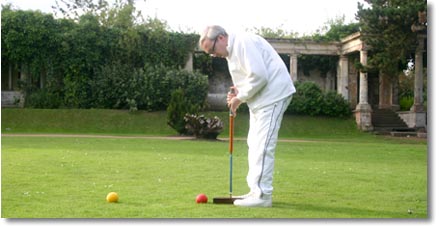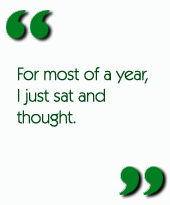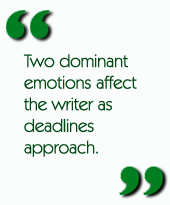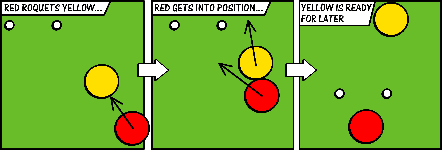
|
Back to |
| The Front Page |
| The Game |
|
The Long Game: A lonely road to authorship |
||||||||||||||||
|
by James Hawkins Posted May 24, 2010
|
||||||||||||||||
|
||||||||||||||||
Two and a half years ago, I was contacted by The Crowood Press, a small UK-based publishing house specialising in niche titles, as you can see in their extraordinary and arcane catalogue. They had previously released a couple of croquet titles, including "The World of Croquet", by John McCullough and Stephen Mulliner; and "Croquet:The Skills of the Game," by Bill Lamb. Now they wanted to publish a new work, aimed at the Association player wanting to develop their knowledge of "advanced tactics".
The publisher's brief alarmed me. Did Crowood really know what they were asking for? My understanding of "advanced" play - with its rarefied peeling breaks, wired leaves and supershot openings - probably diverged greatly from theirs. Maybe Crowood were happy to chase a niche market measurable in tens, rather than hundreds, but it seemed unlikely. After some negotiation, we - my Commissioning Editor and I - decided to focus on a plan to lead aspiring club players from beginner status up to expert level. That was the point where we settled on the title: "Complete Croquet - A Guide to Skills, Tactics and Strategy".

|
| Hawkins' publisher demanded, by contract, more than 100 photographs, and most of them came from archives and photo libraries. A few had to be newly taken, with Hawkins as model. By happenstance, the rain stopped long enough at deadline time to find a suitable site somewhere in South Liverpool's parkland, where Hawkins seeks to establish a croquet club. Here's the author in front of the ruins of Allerton Towers, an 18th Century mansion, on what might have been the family croquet lawn. It's Hawkins' private joke: modern croquet rising from the decay of its aristocratic Victorian origins. |
It's 25 years since I first played at club level, and a decade longer since I picked up a mallet to play in my grandparents' garden. There's a gulf of difference between the social backyard croquet player and the competitive club croquet beginner, but an equally wide gulf between novice tournament player and A-class veteran. My intention was to distil a lifetime of knowledge into the pages of a book. The hope is that an eager player may dip into the book, and use it as a guide to working his way up the playing ladder towards the level of expert. All the highbrow stuff remains - a deconstruction of triple peels, and a critique of the Maugham Standard Opening - but it's developed from the foundation knowledge that every player needs. So I start with how to choose which shot to play, and how to play a good break.
At some point in the future, we'll all be long forgotten. Croquet may have been consigned to extinction. Maybe someone, somewhere, will pick up my book from a dusty library shelf, and will leaf through it. My ethos has been to create something which imparts the flavour of contemporary croquet. That includes advice on how to hold a mallet and which corner to hide Red in, but also my own eccentric ramblings into the folklore of the game.

For those who haven't gone through the experience of writing a book, it's something I wouldn't necessarily recommend. For most of a year, I just sat and thought. Where exactly should you place the fourth ball in a four-ball break? Is it possible, or even desirable, to teach someone everything they'll ever need to know? And just what is the name of that shot where you send Yellow there while going to Blue's hoop? Months went by, and my head was filled with a tangle of croquet thoughts.
Two dominant emotions affect the writer as deadlines approach. One is despair in the face of a complete lack of progress. The other is guilt, as the compulsive need to procrastinate prevents any progress. All day, every day, I'd do the crossword, listen to the cricket on the radio, and drink 15 cups of tea. Eventually, the garbled first draft turned into a nearly adequate second draft. And that led to a polished third and fourth draft.

When a book of this sort is finished, there's no elation and no celebration. There's filing. Then several months of indexing, proofing, and checking the layout. Now, the point where I can finally sit back and enjoy the product of my labour is when I actually have the book in my hands. Eight months after completion of the manuscript, and 31 months after agreeing to the project, I'm now a published author. It's been a mountain to climb, but the view from the summit is wonderful.
ILLUSTRATING WITH CROQUET COMIX
Crowood asked me to source a large number of images for the book, including a vast array of diagrams. I was at a loss as to how to convey all the information I needed, without creating page after page of ungainly pictures of balls and hoops. And then - why had I never thought of this before? - I had a brainwave. Primary colours, simple shapes, and diagrams in sequential frames, all annotated with text boxes. This was crying out to be illustrated as a series of comic strips.
This was a brilliant idea, I told myself. Even when my prose starts to stray into the more esoteric and intellectually severe areas of tactical theory, I can soothe the reader with friendly and cuddly pictures. There comes a point, after you've drawn ten of these, and realise there's another seventy to go, when the idea starts to seem less appealing. After two weeks, my retinas were starting to ache.
With hindsight, it would have been wrong to settle for a more straightforward design scheme. It's almost certain that this is the first and last book I'll ever write on croquet tactics, so this element is as important as the content of the writing. Secretly, I'm rather proud of the way the diagrams have turned out.
Here's a hoop approach:

|
|
Knowing how to play the perfect break isn't much use to you when you're losing. An hour into the game, you're on your third coffee of the morning, you're slumped in a chair, and you still haven't made your first roquet. You know you're a better player than the other guy, but he just hasn't left you with any opportunity to get going. This chapter is all about how to seize control, how to stop your opponent, and how to make sure that he's the one sat next to the lawn in the deckchair. The Outplayer
The advantage is with your opponent. His Blue and Black are together, and your Red and Yellow are split. He has the innings - unless you do something, each of his turns will start with a short hit on his partner ball. And, until the situation alters, he's going to do all the scoring. Three things will change this:
The Choice of Ball It's possible to over-analyse the tactics of the game. If there's a ball which is close enough for you to be guaranteed of hitting, you probably don't want to think more deeply. Control passes to you if you make a roquet, so hit first, and only then think about what to do with your croquet stroke. So, ask yourself -
If the answer's yes, just play the shot. Things get more complex when you're not 100% sure of hitting. At the front of your mind should be the question -
If your Red ball is near Black's hoop, you should certainly think about playing Red. The most dangerous positions for Red are:
Whichever of Red and Yellow features higher on this list is the more vulnerable. The safest option would be for you to play that ball. There's some pressure off you if there's no clear-cut safe option. Maybe Red is near Black's hoop, but not quite near enough, and you're prepared to risk leaving it. Or Red and Yellow are equally safe - or equally dangerous. You now have the luxury of playing the ball you want to, rather than the ball you think you ought to. Here's your third question -
In general, the ball you'd like to play is the one which gives you a better scoring opportunity. If Red has a ball near its hoop, or the chance of an easy couple of shots to dig out a playable break position, then you'll be tempted to opt for a shot with Red. Even better, you might be spoilt for choice, with a promising start for either Red or Yellow. In this case, it's normally better to play your backward ball - the ball with more hoops still to score. So, if Red and Yellow are for Hoops 1 and 4-back, Red has the promise of a twelve-hoop break, while Yellow can only hope for three hoops. Red is the clear candidate for the ball you'd rather play next. Selecting the Target Now you've chosen which ball to play, you need to decide what to do with it. Your options are limited. Let's look at your choices. Option 1. Blue and Black together, Yellow near the boundary. Red shoots at Yellow. There's the chance of a roquet, which gives control back to you. If you miss, Red's joined up with Yellow, and Blue's joined up with Black, some distance away from you. Sometimes this is a good idea. Your opponent will almost certainly try to split you up. That's bad news if he's an experienced player, as he'll stand a good chance of getting a rush on one of your balls. He might turn this into a scoring opportunity. If your opponent is weaker, joining up can be fruitful. It forces him to concentrate on safety play - split Red and Yellow apart before thinking about approaching a hoop. In some games it's the best tactic for coaxing a mistake from your opponent. Option 2. Blue and Black together, Yellow towards the middle of the lawn. There's hardly ever a scenario when it's a good idea to shoot at Yellow gently. Leaving Red and Yellow together in a mid-lawn position is asking for trouble. If you plan to shoot at Yellow, you should aim to reach the boundary if you miss. Shooting hard makes Red less vulnerable to all the bounces and swerves of an imperfect lawn, but it also leaves you much safer. This is often the best choice of shot for Red. There's the option of a roquet on Yellow, but a miss leaves Red safely on a distant boundary. This is a free shot, and gives Red an attacking option which lands defensively after a miss. Hit or miss, there's no real penalty to you. Keep an eye out for free shots - if one presents itself, you hardly need to search further for which shot to take. Option 3. Shooting at Blue and Black. I was taught that it's a bad idea to shoot at the opponent. If Blue and Black are joined up on the boundary, a missed shot at them just donates a third ball to play with. Constantly shooting at the opponent is the trademark of a player who's either a fearless straight-hitter, or someone who never learns from their mistakes. But there are times - and very specific ones - when you can get away with it. If you do hit, the pay-off is usually great. You earn a croquet on Black, with Blue close by. Bearing in mind that it's the start of your turn, and you've not yet taken croquet from Yellow, the prospects look good. When to shoot: 1. Red can land well past Blue and Black if you miss. If Blue and Black are mid-lawn, you've a possible free shot. If they're on the boundary, but you're shooting from an angle, it's possible to shoot, miss, and land well out of reach. 2. Red has a double target at Blue and Black. The gap between the two balls is so small that you can aim for the middle, and expect to hit one or other of the balls. 3. Black has a very short rush on Blue, very close to the boundary. Shoot Red at this, and here's what happens:
There's a chance that Black could sacrifice his position to mess about with Red, and then not regain the rush. Even if he does, Black and Blue are now mid-lawn, and Red is safely on the boundary. Black's rush, left so close to the boundary that he can't exploit the nearby Red, is called an unguarded rush. |
In 2010 James Hawkins celebrates his 25th anniversary as a competitive croquet player. He's played at championship level throughout the UK, and for several years has devoted much of his time to coaching. He was editor of The Croquet Gazette from 2001 to 2005. Despite a serious of delays and setbacks, he is now concentrating on establishing a croquet club in his home city of Liverpool.